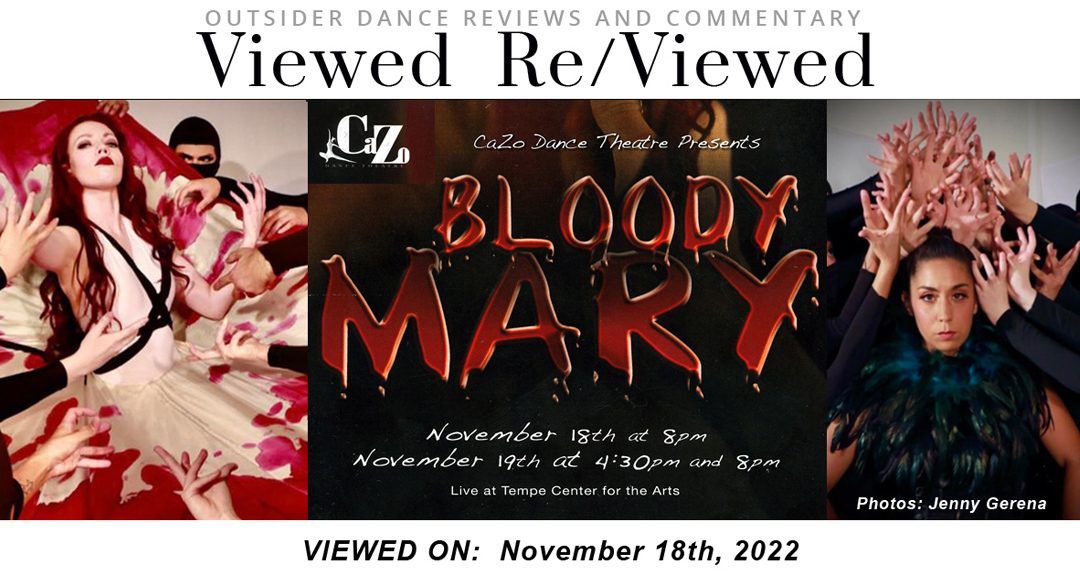Company: CaZo Dance Company
Choreographer: Bridgette Borzillo
Performers: Ally McSpadden, Dominque Bailey, Giovanni Duran, Keanna Agustin, Laura Belvado, Neftali Mendoza, Kelly Rackow, Joseph Redondo, Mackenzie Miranda, April Haskins, Sophia Balbas, Dilsat Dalkiran, Gracie Larson, Shealee Bloom, Rebecca Boizelle, Maddie Miloscia, Megan Ayers, Rachael Haug, Martha Hernandez, Morgan Guttery
Pre-Show Performers and Choreographers: Megan Ayers, Rebecca Boizelle, Sophia Balbas, Shealee Bloom, Dilsat Dalkiran, Morgan Guttery, Rachael Haug, Gracie Larson, Ally McSpadden, Mackenzie Mirenda
This reincarnation of CaZo’s Bloody Mary, despite the fact that it wasn’t staged until November 18th, bodes well for the production becoming a Halloween seasonal favorite. It has a classic theme and innovative production elements that should give it an enduring quality. I had previously seen Bloody Mary twice, on October 25th and 26th of 2019 when it was first performed, and now, after the long Covid hiatus, I very much enjoyed seeing it again this evening.
It was apparent that the piece was not static and had undergone an evolution of sorts. Without being able to re-run a movie of the original, it was hard to know exactly what had changed but I had a sense that certain blocking was different and some of the interactions between the principles seemed, if not new, at least fresh. One of the hallmarks of CaZo’s style is Borzillo’s attention to (and insistence on) dramatic focus for each of the performers – a theatrical element so often absent in dance.
And this was theater. This is, first and foremost, a story being told on stage. And in the absence of language, the dancer’s facial expressions and physical posturing have to carry everything. The principle characters, Bloody Mary and the Queen of the Underworld, displayed some real exceptionalism in that regard. The Queen of the Underworld managed an unrelenting fierceness and singleness of purpose from the moment she took the stage and did not break character, even for the obligatory bow at the end. Bloody Mary, for her part, had a challenging character arc to portray, requiring considerable physical and emotional range. She was alternately regal, joyous, manipulative, fierce, frightened and devastated – and she took the audience with her through it all. This by itself would be high praise, but consider that it extended to the rest of the cast. The young girls at the center of the conflict between the queens went from playful, frivolous and daring to confused, frightened and ultimately totally defeated, and did so convincingly, maintaining their character whether or not they were the focus. This was a powerful tale and the Queen of the Underworld took no prisoners. Well, actually, she took everyone prisoner. You really needed to be there.
While the performance of the principals carried the show, I contend that it was the ensemble that elevated this to art. These were the evil minions of the Underworld Queen, covered head to foot in tight black costumes, including balaclavas over their heads, looking for all the world like a hoard of ninjas. But consider the irony that while their individuality had been effectively erased, the ensemble itself was elevated to the status of a major player, its presence felt in, and often dominating, every scene in which they appeared.
Responding to Borzillo’s (fevered?) imagination, the ensemble became an amazing, organic mass – constantly being configured and re-configured, assembled and dispersed so adeptly you could be forgiven for not appreciating the stunning creativity in its various conceptions or the excellence of its execution. Once again we saw the ensemble turn itself into a throne for the Queen of the Underworld, a grand staircase for the regal descent of Bloody Mary to the stage as well as a launching ramp for her dramatic flight. As individuals, the ensemble was capable of mirroring the motion of a principal’s solo and then turning itself into something amazing like a sculptural base for a highly visual aerial performance. It became tableaus that were beautiful in their own right, and yet functional like an elevated, tree-like structure that subsequently divided and subdivided to the delight and amazement of the audience. And there was the impossible to describe, spinning wheel / merry-go-round / entrapment device which was truly inspired.
There are certainly features of the performance that I found wanting. A tap sequence that arguably went on too long, its intimidating stomp devolving into an extended shuffle ball change before it became the cacophony that ended the scene. Some uneven transitions that confused an already challenging timeline. The curious lack of video reinforcement from a company that has explored this medium extensively. And of course, the regrettable prop that was meant to simulate the mirrored entrance to the underworld.
There is room here for improvement, to be sure, but that is only relevant because this is a production that should live and grow and make its mark in the community. If dance is to reach a broader audience, it desperately needs the accessible showmanship demonstrated in CaZo’s Bloody Mary. In that regard, I would simply direct your attention to the hoard of evil minions. In Borzillo’s hands, the ensemble is variously a character and an object, a malevolent force and an exotic structure, instantly transitioning from person to prop. My admiration for this element is huge. It elevates the entire production and makes it worthy of a much larger stage, a broader audience and is certainly a standout in the local dance community which has not seen its equal.
Bridgette Borzillo continues to accentuate the value of entertainment in her CaZo productions while still showcasing the artistry of her dancers. Her inclusion of a pre-show performance was a welcome distraction while we were being seated. All of this is focused on the audience, and speaking for the audience, we are the richer for it.
Viewed Re/Viewed


Recent Comments